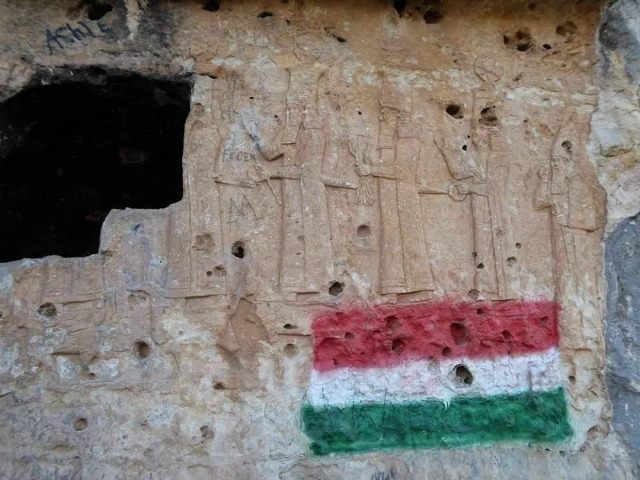Images from Iraq reveal that vandals have painted a Kurdish flag over a seventh-century BC Assyrian relief in Dohuk, Iraqi Kurdistan.
@hellen__87 @AngusMcKeeFCO @KurdistanRegion The Maltai Assyrian relief in Duhok was recently vandalized as well… pic.twitter.com/87eu3w8nZE
— Adam Mirani (@amirani87) February 22, 2016
Artists carved the Maltai relief scene “during the reign of Assyrian King Sennacherib in the 7th century BC.” The four panels show the king “conversing with the gods.” Met Museum reports:
Located in remote mountainous areas, the northernmost and best preserved of these reliefs were sculpted into cliffs on the bank of the river Rubar Dohuk, opposite the town of Maltai (fig. 1), about 70 kilometers north of present-day Mosul, Iraq (see map). The iconography and location of this group of reliefs are of particular interest. Unlike other examples of Assyrian royal art, in which the king is represented worshipping symbols of gods, these reliefs show the king gesturing in front of anthropomorphic deities, or gods in human form. They depict a relatively small figure of the king as a worshipper facing right toward a line of five large gods and two goddesses mounted on animals and fantastic beasts, including from right to left, the gods Ashur, Ninlil, Sin, Anu or Enlil, Shamash, Adad, and Ishtar. Another figure of the king, facing left, is depicted at the end of the row of deities, creating a composition of divine figures flanked by two identical royal images.
Although the king is not represented standing on an animal, his similarity to the gods is implied; he, too, carries an attribute in his right hand. Furthermore, the king is also represented within the rings held by the three first deities from right to left: Ashur, Ninlil, and Sin. By integrating the royal figure within a divine attribute, he could have been perceived as if he were a secondary god, an impression reinforced by another image of the king shown supporting the goddess Ninlil’s throne.
Dohuk, whose suburbs include Maltai, boasts more than one million Assyrians. The city took in many Yazidis and Assyrians who fled the Islamic State (ISIS/ISIL).
Assyrians settled in Maltai 2,700 years ago. The name comes from “ma’altha, meaning ‘the entrance,’ since it gave the ancient Assyrians access into the more rugged mountains to the north.”
There have not been reports of Kurds attacking Assyrians in Iraq, but in Syria, tensions have risen between the Christian ethnic group and Kurds. Brett McGurk, President Barack Obama’s envoy to the anti-Islamic State coalition, promised a new Syrian constitution will give Kurds autonomy. Lt. Col. Sargis Sangari, an adviser to the Christian Assyrian Army, believes the Syrian Kurds will “eradicate the Assyrians in Syria and their Christian culture.” He said:
When America and its Western allies, all part of the Christian world, say we’re going to take this land and give it to Kurdish Muslims who don’t practice the Christian Assyrian culture, they are doing nothing more than killing Christianity in the Middle East with their own hands and they don’t even know it. They’re killing it.
Last month, Assyrians and Kurds clashed in northern Syria, leaving four dead.
“The city of Qamishli is controlled by Assyrians, but surrounded by Kurdish fighters. The Assyrians were trying to set up checkpoints and were fired at by the Kurds,” explained Afram Yakoub, chairman of the Assyrian Federation of Sweden.

COMMENTS
Please let us know if you're having issues with commenting.